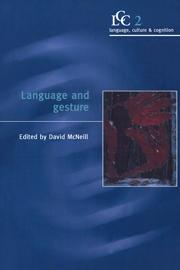Introduction
Published online by Cambridge University Press: 07 January 2010
Summary
Introduction
The word ‘gesture’ needs no explanation. Yet how we use the term in this book is liable to be misunderstood. We are discussing a phenomenon that often passes without notice, though it is omnipresent. If you watch someone speaking, in almost any language and under nearly all circumstances, you will see what appears to be a compulsion to move the hands and arms in conjunction with the speech. Speech, we know, is the actuality of language. But what are the gestures? This book aims to answer this question, at least in part.
It is useful to introduce a set of distinctions to help situate our question. In the process, we will clarify the subject matter of this book and simultaneously sharpen the sense of the word ‘gesture’ with which we are concerned.
The nature of the phenomenon: four continua
I have put this title into the plural because there are several dimensions on which we need to distinguish movements that are equally well called ‘gestures’. The labels for the points along the continua – “gesticulation,” “pantomime,” “emblem,” and “sign language” – were first defined by Kendon (1982). They were lined up on a continuum termed “Kendon's continuum” by McNeill (1992). That single continuum is now subdivided into four continua, each an analytically separate dimension on which the types of gestures above can be differentiated.
Types of gesture
It will be helpful in the following to have specific examples of gestures at each of the points on Kendon's continuum.
An example of gesticulation is “he grabs a big oak tree and bends it way back” (McNeill 1992).
Information
- Type
- Chapter
- Information
- Language and Gesture , pp. 1 - 10Publisher: Cambridge University PressPrint publication year: 2000
Accessibility standard: Unknown
Why this information is here
This section outlines the accessibility features of this content - including support for screen readers, full keyboard navigation and high-contrast display options. This may not be relevant for you.Accessibility Information
- 39
- Cited by
